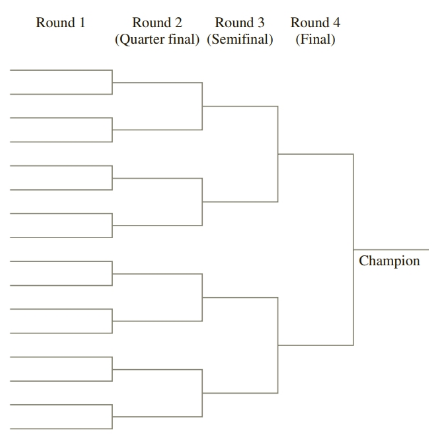
Concept explainers
Elimination Tournaments In an elimination tournament the teams are arranged in opponent pairs for the first round, and the winner of each round goes on to the next round until the champion emerges. The following diagram illustrates a 16-team tournament bracket, in which the 16 participating teams are arranged on the left under Round 1 and the winners of each round are added as the tournament progresses. The top team in each game is considered the “home” team, so the top-to-bottom order matters.

To seed a tournament means to select which teams to play each other in the first round according to their preliminary ranking. For instance, in professional tennis and NCAA basketball the seeding is set up in the following order based on the preliminary rankings: 1 versus 16, 8 versus 9, 5 versus 12, 4 versus 13, 6 versus 11, 3 versus 14, 7 versus 10, and 2 versus 15.23 Exercises 65–68 are based on various types of elimination tournaments. (Leave each answer as a formula.)
a. How many different seedings of a 16-team tournament are possible? (Express the answer as a formula.)
b. In how many seedings will the top-ranked team play the bottom-ranked team, the second-ranked team play the second-lowest-ranked team, and so on?
Want to see the full answer?
Check out a sample textbook solution
Chapter 6 Solutions
Finite Mathematics, Loose-leaf Version
- Please help with a detailed explaination how to get the answerarrow_forwardMATLAB. Awnser written questions (*) in the comments. Null, Rank, and most functions outside of rref() and disp() are not allowed!arrow_forwardMATLAB. Awnser written questions (*) in the comments. Null, Rank, and most functions outside of rref() and disp() are not allowed! Solutions must be given manually! Elementary form means to reduce to RREF manually, without rref(). Please see other attached image for explanationarrow_forward
- In ΔEFG, e = 520 inches, ∠E=26° and ∠F=107°. Find the area of ΔEFG, to the nearest 10th of an square inch.arrow_forwardIn ΔXYZ, ∠Y=90° and ∠X=25°. ∠ZWY=73° and XW=7.2. Find the length of WY to the nearest 100th. Figure not necessarily drawn to scale. XYWZ25°73°7.2?arrow_forwardIn ΔABC, a = 380 inches, ∠A=72° and ∠B=9°. Find the area of ΔABC, to the nearest 10th of an square inch.arrow_forward
 Holt Mcdougal Larson Pre-algebra: Student Edition...AlgebraISBN:9780547587776Author:HOLT MCDOUGALPublisher:HOLT MCDOUGAL
Holt Mcdougal Larson Pre-algebra: Student Edition...AlgebraISBN:9780547587776Author:HOLT MCDOUGALPublisher:HOLT MCDOUGAL Glencoe Algebra 1, Student Edition, 9780079039897...AlgebraISBN:9780079039897Author:CarterPublisher:McGraw HillAlgebra & Trigonometry with Analytic GeometryAlgebraISBN:9781133382119Author:SwokowskiPublisher:Cengage
Glencoe Algebra 1, Student Edition, 9780079039897...AlgebraISBN:9780079039897Author:CarterPublisher:McGraw HillAlgebra & Trigonometry with Analytic GeometryAlgebraISBN:9781133382119Author:SwokowskiPublisher:Cengage Algebra and Trigonometry (MindTap Course List)AlgebraISBN:9781305071742Author:James Stewart, Lothar Redlin, Saleem WatsonPublisher:Cengage Learning
Algebra and Trigonometry (MindTap Course List)AlgebraISBN:9781305071742Author:James Stewart, Lothar Redlin, Saleem WatsonPublisher:Cengage Learning






